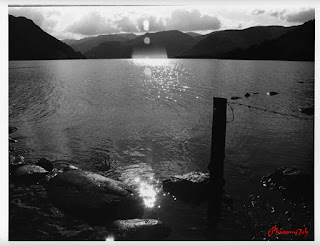 |
I
don't know about you but sometimes I find the constraint of
having to make a segmented test print to determine the right exposure
for each negative tiresome. I sometimes feel that it interferes with
the creative process. On these occasion in the darkroom I put myself
to the test with what I call free printing. I can see some of you
shaking your heads at such a notion. It is a way of pushing your
instincts creatively.
Let
me lay out the rules of this creative freedom. I pick a random sleeve
of negatives, run my eye over them to see what catches my attention.
Load that negative into the enlarger and then make a half sheet test
strip at five second intervals. This will be the only test strip of
the session providing the starting point for each subsequent negative
I opt to print. I give myself two attempts at getting the exposure
right using my experience and knowledge (best guess) to refine it
with dodging and burning. This is where your print technique is put
to the test and your ability to choose negatives of the same density.
 |
| First print. |
Into
the darkroom. I have chosen a set of 35mm negatives that have a
selection of landscapes I made while I was in the lake district and
the one that took my eye was looking across the lake into the sun. As
gooder place as any to start the printing session.
 |
| After adjustments |
With
this negative loaded I set up the enlarger as follows: the lens to F8
and the paper grade to three. These are the most common settings I
use when printing. The paper used is silverproof matt. With the test
strip made I look carefully at it to work out the overall exposure
and how much more light may or may not be needed for a balanced
print.
The
mountain into the sun image is the one I made the test strip for.
Even so it proved difficult to get right. I chose to print overall at
32 seconds adding an extra 15 secs for the sky. This did not allow
for the mountain slops on the left of the picture which needed less
light to stop them completely blocking out. The burning in of the sky
did not take into account the brighter area to the center right
leaving it a bit blown out. So for the second print the mountain
slops to the left were held back for -7 secs and the off center sky
received a further +15 secs.
 |
| Before adjustments |
 |
| After adjustments |
The
second negative chosen was the fence post into the sun. I already
knew that overall this would require less light to print, the trick
here would be by how much, after a bit of consideration I opted for
27 secs. Which worked well but I felt it needed even less. Overall
the second print was exposed for 24.5 secs with an added 5 secs for
the sky. Not much of a change, but the affect on the foreground was
positive.
 |
| Before |
 |
| After |
 |
| Right first time no adjustments |
The
third negative is of the dog in the lake. I chose 25 seconds for this
because the negative looked a bit dark indicating some over exposure.
I was too bold with my exposure time as the print is a bit washed out
with no sky. So I up it to 28 secs and added +28 for the sky. In
cases where the sky is whited out I double the amount of light when
burning in. Overall a much better picture.
The
final image looking through the trees is a straight print, the
overall time is 27 seconds. I'm happy with the print, yes I could
adjust a couple of bits, but they would not add much to the overall
look.
Free
flow printing sessions are not always successful but it does free my
mind especially if I'm having a bad time getting a picture the way I
want it.









































